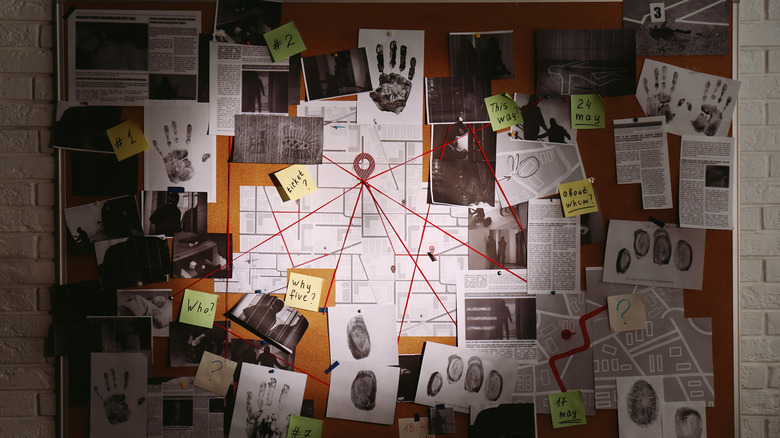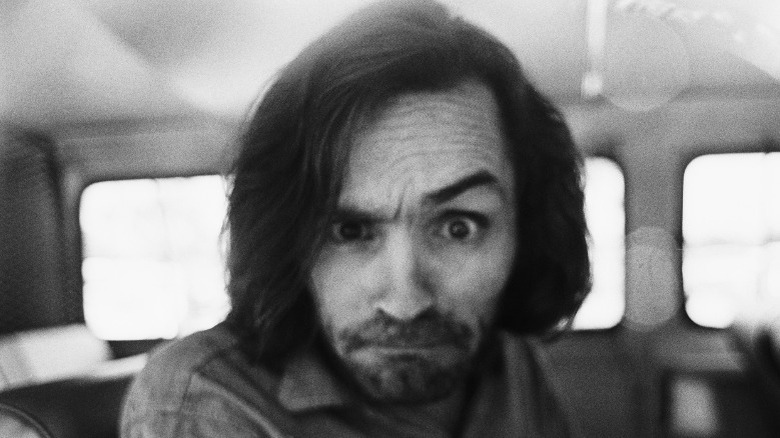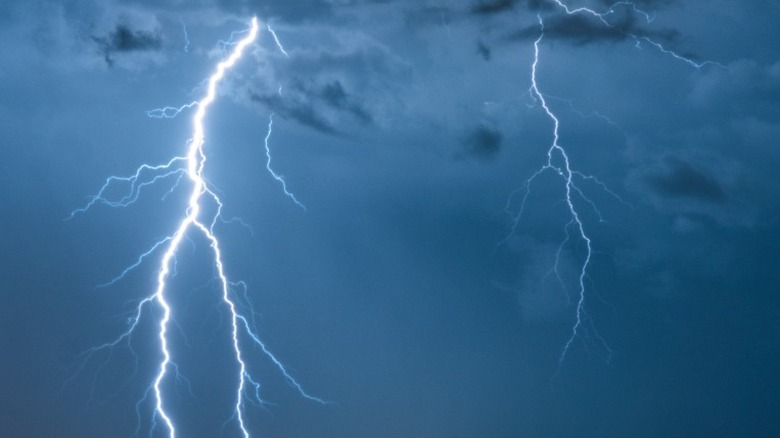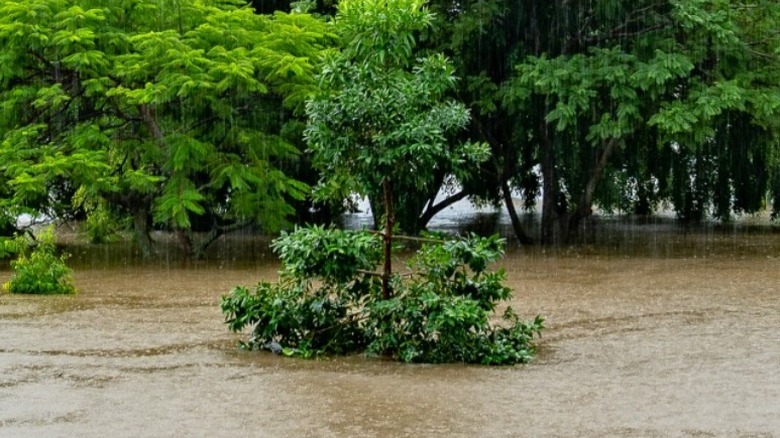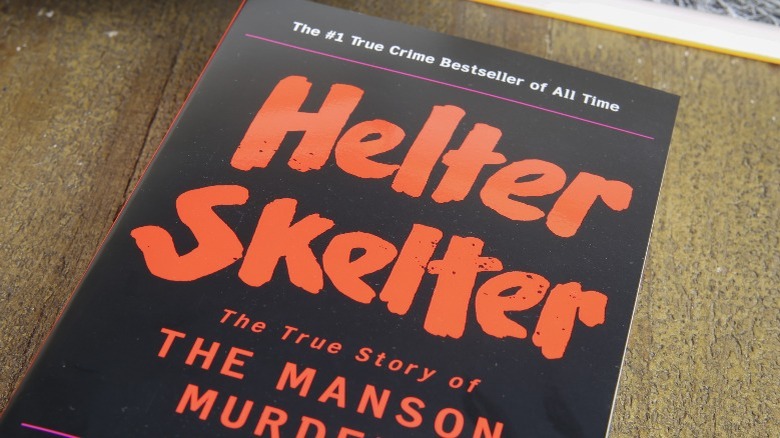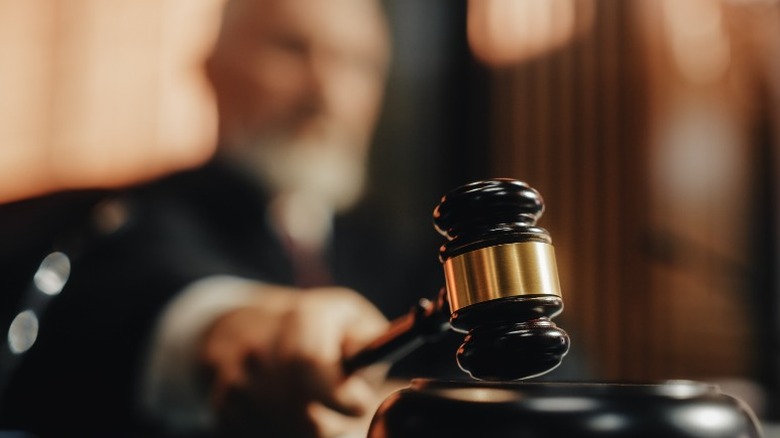The Death Of The Manson Family Attorney, Ronald Hughes, Has Sparked Theories For 50 Years
The August 1969 Tate-LaBianca murders shook the world and shined a spotlight on Charles Manson and the killers, who he ordered to carry out lethal attacks on seven victims. As if the horrific murders themselves weren't fodder for the media, the arrest and trial of Manson and three co-defendants should have made the presses run dry of ink. A seven-month-long trial took place in 1970, becoming the longest trial in American history (per History) until the 1984 McMartin child abuse trial topped it (via The New York Times).
Representing a high-profile client for multiple murders can carry certain risks. This could have been the case for attorney Ronald Hughes, who was reportedly going to represent Manson at his historic trial. Two weeks before the trial began, Manson replaced him with attorney Irving Kanarek (via UMKC Law). This didn't take Hughes out of the picture, however. Manson was being tried alongside Patricia Krenwinkel, Susan Atkins, and Leslie Van Houten, each of whom would need their own legal counsel. Hughes represented Van Houten, a move that some speculate might have cost him his life.
Hughes angered Manson throughout the trial
Prosecutor Vincent Bugliosi pointed out in an interview that Charles Manson was seeking what is known as an "umbrella defense," in which the sole purpose was to get him alone exonerated. But Hughes, hired to represent Leslie Van Houten, worked to secure and present the best defense for his client. This meant combatting the idea that she, along with co-defendants Susan Atkins and Patricia Krenwinkel, acted of their own free will and did not receive any order to kill from Manson.
Manson's followers acting in concert was tantamount to his defense strategy. Should any one of his co-defendants say under oath that they were acting on his behalf, Manson's case would have been doomed. Fully aware of this, Manson's attorney, Irving Kanarek, immediately rested their case the moment the prosecution rested theirs. This prompted outbursts from Manson and the others on trial, who demanded that they be able to testify. Their plan was to get on the stand and state that they planned and committed the murders without Manson, helping their leader but damning themselves.
Of this tactic, Ronald Hughes stated (per True TV) that he refused "to take part in any proceeding where I am forced to push a client out the window." After Manson was allowed to testify on his own behalf, he told Van Houten, Atkins, and Krenwinkel that their words on the stand were no longer needed, leaving him the only person who testified for the defense. Still, Hughes' work on Van Houten's behalf angered Manson, who recognized that the attorney had better odds of obtaining an acquittal for his client if Manson could be shown as having control and undue influence over some of his followers. Some theorize that Manson may have taken revenge.
Hughes was camping with friends when disaster struck
After both sides presented their cases, Judge Charles Older declared a 10-day recess to give time for the state and the defense to prepare their closing arguments. When the trial was brought back into session on November 30, 1970, Hughes was conspicuously absent (per A&E).
It was revealed that Hughes had embarked on a camping trip to Sespe Hot Springs. Hughes didn't have a vehicle but was able to get a ride there with two friends. According to "Unsolved Mysteries," Hughes journeyed to the campsite with James Forsher and Lauren Elder in Elder's Volkswagen Microbus. Days into their trip, the Los Padres National Park was hit by rainstorms, triggering flash flooding. Elder and Forsher decided to leave, but Hughes wanted to stay and enjoy the rest of the trip. As the VW was stuck in the mud, the two were forced to walk out on foot and hitchhike back home.
When Hughes didn't show up to court after recess, a search party was formed. Elder's VW was located, along with the scattered court paperwork that Hughes had brought with him on the trip. Mysteriously, the file containing Leslie Van Houten's psychiatric reports was nowhere to be found. And neither was Hughes. Suspecting foul play, police immediately questioned Elder and Forsher in hopes of getting a solid lead or a confession. But Hughes' friends were steadfast in their account of what happened. They even submitted to polygraph testing and passed. Subsequent foot and helicopter searches turned up no trace of Hughes, who was now feared to be dead.
An investigator claimed Hughes likely died due to the heavy flooding
The weather conditions in the area where Ronald Hughes was last seen prompted some to speculate that he had succumbed to the elements. On March 29, 1971, the day that Charles Manson and his followers were sentenced to death for their crimes (via History), two fishermen made a grisly discovery: a badly decomposed body wedged in between two large rocks. It had been washed down a creek a good distance and showed no signs of foul play or injuries consistent with violence. "Unsolved Mysteries" tells us that Hughes' body was so far gone that he had to be identified by his dental records.
After examining the body, the coroner ruled that the cause of death of "undetermined." However, this ruling does not mean that they felt foul play was responsible. Charlie Rudd, who investigated the Hughes case for the Ventura County Sheriff's Department, stated that the heavy rains in that area would have swept Hughes off his feet. From his perspective, the attorney was overcome by the water and simply drowned.
But this revelation did little to stop growing speculation that Hughes' death was not an accident and that he was targeted by Manson for revenge.
One theory is that Hughes was murdered on Manson's orders
The chilling last words Charles Manson spoke to Ronald Hughes may have helped put forth the idea that he ordered the attorney's death. "Attorney, I don't ever want to see you in this courtroom again," was the order barked at Hughes by the defendant just before the trial went into its 10-day recess (per "Hunting Charles Manson"). It would end up being almost prophetic, as Hughes died days later.
Vincent Bugliosi put forth the theory that Manson had Hughes murdered out of revenge. According to "Unsolved Mysteries," the Manson trial prosecutor was in total disagreement with the Ventura County Sheriff's Department and wanted a full investigation into Hughes' death. Though this request was ultimately denied, the fact that someone with some authority purporting that murder was a strong possibility gave more credence to the theory that Manson had ordered a murder.
Adding to this theory was what former Manson Family member Sandra Goode revealed to documentary filmmakers in December 1975. She claims that "the family" was responsible for nearly 40 murders and that Hughes was the first revenge killing. A year later, Bugliosi received a phone call from an anonymous source that told him that Manson ordered Hughes' death after Hughes angered him in the courtroom.
Van Houten was nearly aquitted
Ronald Hughes' disappearance left Leslie Van Houten without legal representation for the rest of the trial. Though the defense had already rested, she was appointed a new lawyer for the remainder of the proceedings. After being found guilty and sentenced to death, Van Houten filed for an appeal. The Lodi News-Sentinel reports that the appeals court ruled in her favor, stating that Hughes' disappearance resulted in her having an unfair trial. She was granted a new one, but the jury deadlocked. Of the 12-member panel, seven voted to find her guilty of first-degree murder, while five voted to find her guilty of manslaughter. Already in over $1 million for both trials, the state tried a third time to get Van Houten convicted.
Her legal defense strategy of blaming heavy LSD use and Manson's cult influence did not play out well the third time. In July 1978, Van Houten was found guilty of the murders of Leno and Rosemary LaBianca (via The Spokesman-Review) and sentenced to seven years to life in prison (per the Los Angeles Times).
